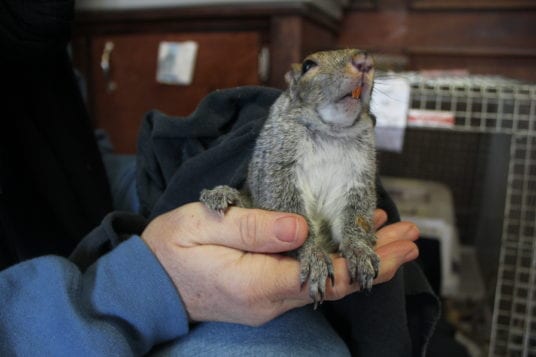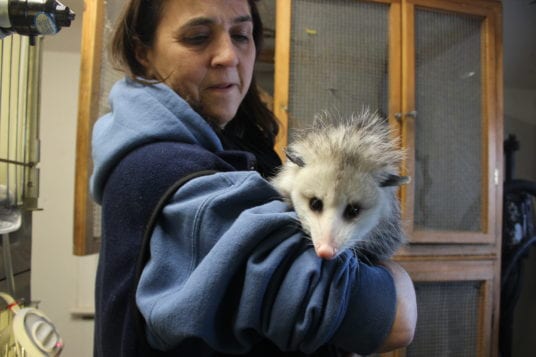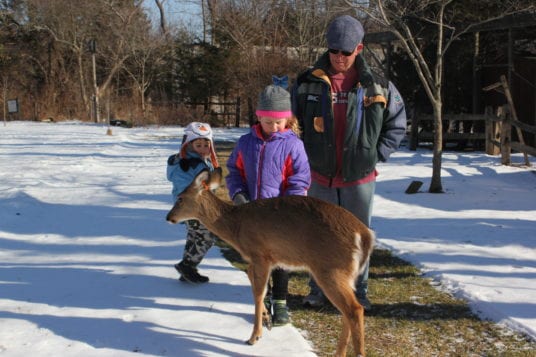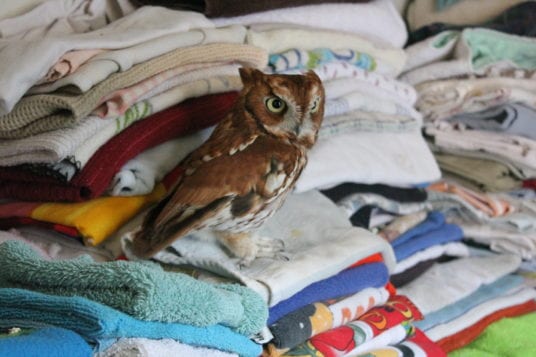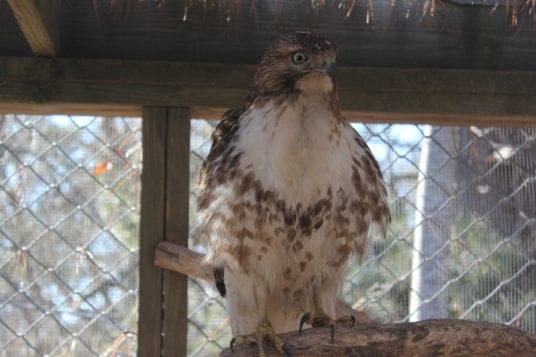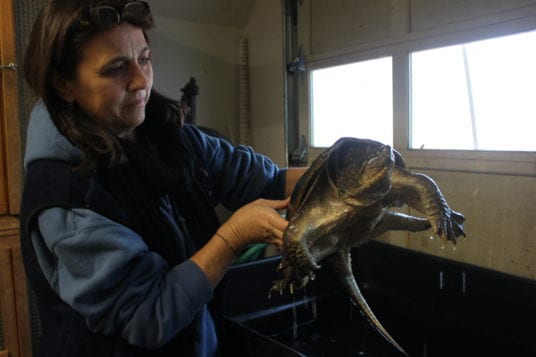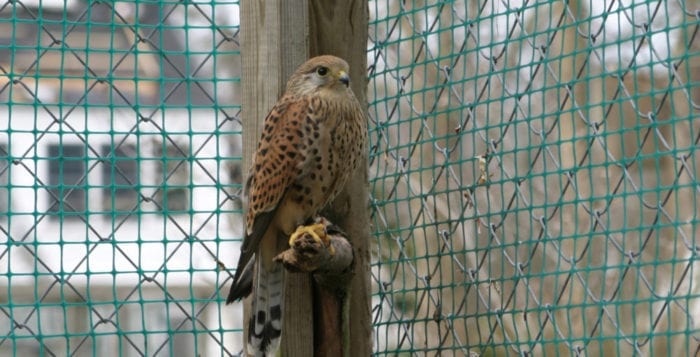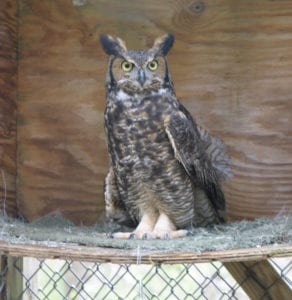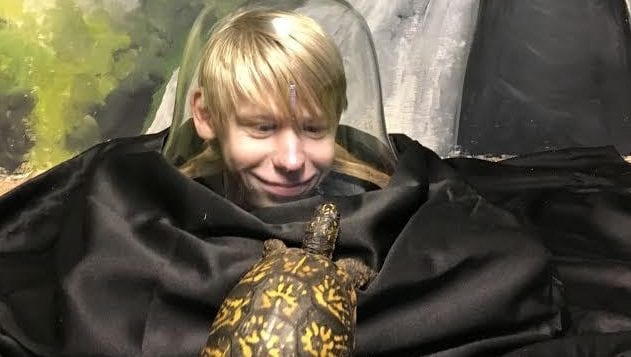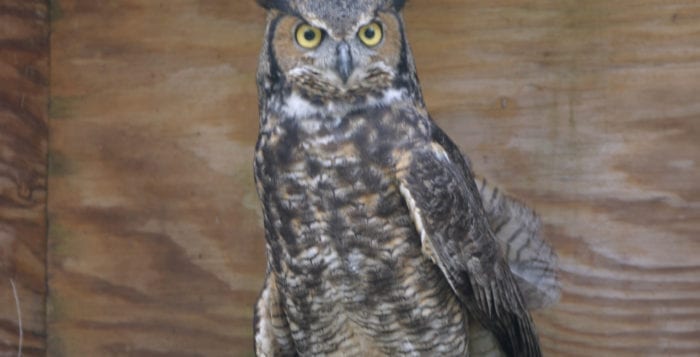A haven for Long Island’s injured wildlife
By Kevin Redding
Three weeks ago at a construction site in Elwood, a young red-tailed hawk was lying on the ground with its eyes closed. It had been hit by a car and its skull was fractured.
But today, that same bird of prey can be found perched inside a spacious flight aviary at Sweetbriar Nature Center in Smithtown, gliding from one branch to another and darting its head in every direction in search of its next meal. Dan’s Bird, as it’s known on the property after it was rescued by Daniel DeFeo, a Sweetbriar volunteer since 2015, will eventually be released back into the wild as one of more than 1,000 injured animals the nonprofit will rehabilitate this year.
“As a wildlife rehabilitation center, we are about 50 percent successful with what goes back into the wild, where most other centers are at about 30 percent,” said Janine Bendicksen, Sweetbriar’s curator and wildlife rehabilitation director. “We can do everything a vet hospital can do except surgeries, as far as medications and setting bones. We’re also the only center where people can just walk in and drop animals off. It’s a real service to the public.” Whatever the site can’t do on its own, she added, is handled by the staff at Best Friends Veterinary Care in Nesconset.
All in a day’s work
On a recent sunny Saturday afternoon, Bendicksen — who has been at Sweetbriar for 18 years, is at the site five days a week and is in charge of teaching educational programs, fundraising for big events and running the summer camp and wildlife rehabilitation camps — made her rounds throughout the property, making sure to greet every critter along the way, including permanent wildlife patients like Einstein the screech owl, who has suffered a broken wing and leg and takes shelter among piles of towels and blankets inside a laundry room; Jack, a kestrel with a missing eye and a crossed beak due to exposure to the pesticide DDT; an old turkey vulture that was hit by a car in Pennsylvania, broke its hock and sustained a wing fracture; and an opossum that was found starving to death and is expected to be released in the spring.
There are also box turtles, mallard ducks, rabbits and chipmunks. A groundhog and a deer too. The site is licensed to take in almost any animal, Bendicksen said, except rabies vector species like raccoons and skunks.
Squeezed into a tiny wooden habitat, Bendicksen summoned two flying squirrels from inside a nesting box. Although they are nocturnal, she said these animals only slip into semihibernation during the day and can be woken up to eat and play. “These guys came from somebody’s attic,” she said. “Every couple of weeks we get another one because somebody uses a Havahart trap to catch them.”
Even though the nonprofit, which officially opened in 1986, has been rehabilitating wildlife for more than 30 years, Bendicksen said the program has grown in “leaps and bounds” over the last decade and each year the site takes in more and more. This is due to both Sweetbriar’s growing popularity in the community and people and developments “encroaching on animal’s habitats,” Bendicksen said.
The goal of Sweetbriar, of course, is to bring every animal back into the wild, and specifically back to exactly where they were found, but in many cases, the outcome depends on the specific animal and its situation. For instance, some injured animals can’t live in captivity and these — as well as animals that don’t recover from their severe traumas — must be euthanized.
“It’s the humane thing to do,” Bendicksen said. “Seagulls come in all the time and they don’t do well in captivity. While in cages, they get what’s called bumblefoot [inflammation on the soles of the feet], which they eventually die from.”
Not long after she explained this, William and Mary Krumholz of Smithtown brought in a box containing a seagull they found hobbling in the Costco parking lot.
“It looks like the wing is broken,” William Krumholz said. “It could hardly run away from me. It was only a matter of time before it got run over.”
After wrapping the seagull in a towel and doing some quick detective work in the rehabilitation room, Bendicksen deduced more than likely it was struck by a car, and found that the last digit of its wing was separated and hanging on by a part of the bone. She assured the Krumholzs that it would be taken to the veterinarian to be checked out further and told them about the inflammation concern with seagulls.
“But, if that’s the case, what you did do was save him from starving to death or being eaten or run over,” she said to them. “We’ll do our best.”
Mary Krumholz nodded her head. “I mean, that’s nice, but … It was only a car ride over here and I already feel bad.”
Bendicksen later said one of the most challenging parts of the job was to resist the urge to become attached to the animals that come in.
“It’s why we try not to give names to any injured animals we release, just the permanent ones,” she said, “because you become too close to the animals and it makes it very, very hard if you have to make a difficult decision. We wish we could release everything back where we found them.”
The human touch
People have been bringing animals to Bendicksen to be patched up since she was a young girl growing up in Hauppauge.
“There are little kids here who just stick their hands into cages and that would’ve been me — I was always told to be a veterinarian,” Bendicksen said. “My mom’s friends would call and say, ‘The cat just grabbed a baby bunny and it survived.’ I would always build little habitats for them and make sure they had a comfortable bed, even if it was just, like, a frog.”
Bendicksen grew up to be the owner of a children’s clothing business called Janine, which employed stay-at-home moms. In the late 1990s, however, she was diagnosed with stage IV breast cancer, which forced her to give up everything for a while.
“I went through two years of hell and then had to kind of start my life over again,” she said. When she became cancer free, she came to Sweetbriar with her children for one of its volunteer picnics. She struck up a conversation with the site’s director, who, after finding out more about her, asked if she’d be interested in helping them curate the site.
After some extensive training, a licensing process and testing from the New York State Department of Environmental Conservation, Bendicksen was a teacher on the site. It didn’t take long before she became director of wildlife rehabilitation. “This place saved my life,” she said. “What makes you happy as a child should be what you do as an adult. I’m extremely lucky.”
Val Timmerman, a Stony Brook University student and one of Sweetbriar’s 14 volunteers, said everything she knows she learned from Bendicksen.
“She’s so awesome and knows everything,” said Timmerman, who stumbled across Sweetbriar almost two years ago while searching for animal rescue facilities close by. “Being able to make even a small difference in the patient’s lives, making things a little bit better for them, is what I love. And, of course, releasing them, finding out that a possum or something we didn’t think was going to make it is doing so well now. It’s great.”
Bendicksen said without her volunteers, the site wouldn’t survive. “These people are near and dear to my heart,” she said.
DeFeo, who studies biology at Suffolk County Community College and hopes to be a zookeeper one day, is at Sweetbriar every Saturday between 9 a.m. and 4 p.m. taking care of all the birds of prey on the property, preparing all their food, changing their water bowls and cleaning out their dirty cages.
“I’ve always loved animals,” DeFeo said. “Just going out there and saving an animal’s life — it’s such a beautiful feeling. And I always feel a sense that I will do anything to save that life.”
Before pursuing the animal field, DeFeo said he was an electrician. But he knew he had to call it quits after nearly suffering a severe injury.
“If I fell off a ladder and broke my back, I’d be miserable for the rest of my life,” he said. “But if I got my arm bitten off by an animal, I’d probably still be happy and go to work the next day. This is what I’m meant to do.”
How you can help
“The public needs to be better educated on what they need to be afraid of, what they shouldn’t be afraid of and what they should do when they find an animal,” Bendicksen said, adding that any and all residents who do come across an injured animal should call Sweetbriar before handling it or bringing it in.
Here are some helpful tips Sweetbriar staff members have assembled:
• Baby birds are often seen fully feathered but trying to fly, with the parents nearby. These are fledglings. If they look bright and alert, it is best to leave them alone. If possible, keep cats and dogs away from the area for a few days in which time the birds will learn to fly. The parents will continue to care for them even though they are on the ground. If you are not sure the parents are nearby and you are concerned, you may put the bird in a nearby bush or on a tree branch and observe from inside the house for a few hours. If the mother sees you in the yard she will not come near.
• If an adult bird can be caught, probably something is wrong and it needs help.
• If you encounter any kind of turtle crossing the road, it is okay to help it along. However, please carry it to the side of the road in the direction it is heading. By putting it back on the side it is crossing from, it will start crossing the road all over again.
• If an opossum is found smaller than 8 to 10 inches, it probably needs attention. Orphaned babies are often found looking for food near a dead mother, especially alongside roads. These animals rarely contract rabies because of their low body temperature.
• DO: Place the animal in a secure cardboard box with small holes placed on the side or lid. The box should be just big enough for the animal to stand and turn around, to prevent the animal from thrashing around and hurting itself. Place paper towels or a T-shirt on the bottom of the box.
• DON’T: Keep peeking at the animal or handling the animal. The more you look at an animal or handle it, the more you stress the animal and reduce its chance of survival. Resist the temptation to put an animal inside your shirt. Cute little squirrels are notorious for being covered with fleas.
Sweetbriar Nature Center is located at 62 Eckernkamp Drive in Smithtown. The center is open daily from 8:30 a.m. to 4:30 p.m. For more information, call 631-979-6344 or visit www.sweetbriarnc.org.


